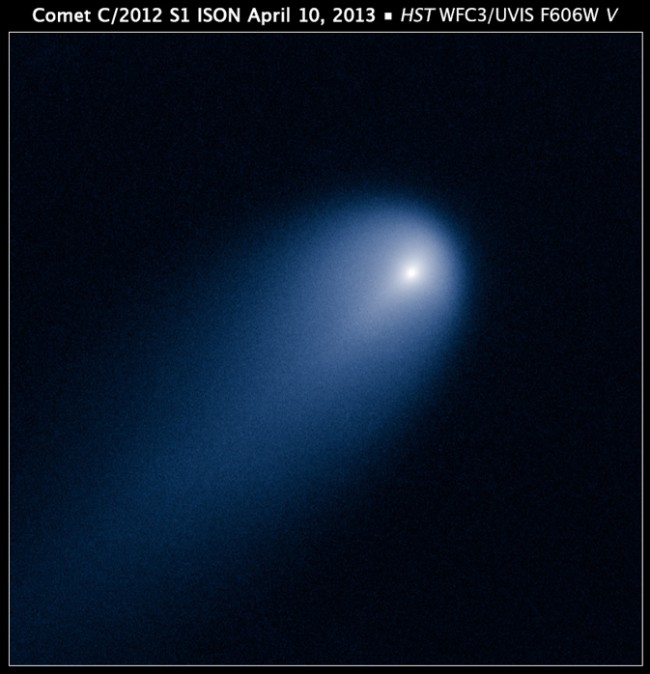FROM STEVE KLEYN
Hubble sees Comet ISON 24 April: Later this year, Comet ISON is expected to become a naked-eye object when it skims through the atmosphere of the Sun. The Hubble Space Telescope has just obtained a sneak preview when it photographed ISON on 10 April. At the time, the comet was 386 million miles from the Sun (394 million miles from Earth), just inside the orbit of Jupiter. Even at that great distance the comet is already active, as sunlight warms the surface and causes frozen gases to vaporize. A detailed analysis of the image reveals a strong jet blasting dust particles off the sunward-facing side of the comet’s nucleus.
Astronomers are using Hubble images to measure the activity level of the comet and constrain the size of its icy nucleus. Preliminary measurements suggest that the ISON’s nucleus is no larger than three or four miles (~5 to 6 km) across. This is remarkably small considering the high level of activity observed in the comet so far, said researchers
The comet’s dusty atmosphere, or “coma”, is approximately 3,100 miles across, or 1.2 times the width of Australia. A dust tail extends more than 57,000 miles, far beyond Hubble’s field of view. A more careful analysis is under way to improve these measurements and to predict the comet’s activity when it skims 700,000 miles above the Sun’s roiling surface on 28 November.
More amazing discoveries continue for Hubble
Astronomers using the NASA/ESA Hubble Space Telescope have shown for the first time that bursts of star formation have a major impact far beyond the boundaries of their host galaxy. These energetic events can affect galactic gas at distances of up to twenty times greater than the visible size of the galaxy — altering how the galaxy evolves, and how matter and energy is spread throughout the Universe.
During these bursts, hundreds of millions of stars are born, and their combined effect can drive a powerful wind that travels out of the galaxy. These winds were known to affect their host galaxy — but this new research now shows that they have a significantly greater effect than previously thought.
An international team of astronomers observed 20 nearby galaxies, some of which were known to be undergoing a star-burst. They found that the winds accompanying these star formation processes were capable of ionising gas up to 650,000 light-years from the galactic centre — around twenty times further out than the visible size of the galaxy.
Star-bursts are important phenomena. “They not only dictate the future evolution of a single galaxy, but also influence the cycle of matter and energy in the Universe as a whole,” says team member Timothy Heckman, of Johns Hopkins University. “The envelopes of galaxies are the interface between galaxies and the rest of the Universe — and we’re just beginning to fully explore the processes at work within them.”
The team’s results will appear in the 1 May 2013 issue of The Astrophysical Journal.
Kepler discovers smallest ‘habitable zone’ planets
“18 April 2013: NASA’s Kepler mission has discovered two new planetary systems that include three super-Earth-size planets in the ‘habitable zone’, the range of distance from a star where the surface temperature of an orbiting planet might be suitable for liquid water.”
This headline news from NASA makes one wonder how long it will be before the discovery of a planet with actual real life hits the headlines of world news. Kepler’s findings will soon be reinforced by the anticipated launch of new space telescopes with even higher powers of resolution specifically intended for finding Earth-like planets in nearby sun/planet systems.
Which brings us to ponder again the as yet unanswered Fermis Paradox. This is well described by The One Minute Astronomer in his newsletter of 23 April. “While having lunch one day with colleagues at Los Alamos Labs in 1950, Enrico Fermi, one of the most astute physicists of the 20th century, posed a fascinating question. Fermi pointed out that since the universe contains countless trillions of stars, and if even a tiny fraction of these stars had planets that harboured intelligent civilizations, then there must be thousands or millions of civilisations capable of interstellar communication and perhaps even space travel. “So where are they?” wondered Fermi. Since there are no signs of such civilisations, they must not exist. This is known as Fermi’s Paradox, and it has bedevilled astronomers and amateur philosophers ever since.”
Theories which could explain Fermis Paradox abound, but none has yet come close to giving an answer. They vary from “there are no other intelligent lifeforms” (a rather stultifying thought) to “We have yet to develop the ability to communicate”.
The one which makes me feel most vulnerable is based on the idea that other intelligent life is already here. Perhaps even right here on Earth. But we are as yet unable (insufficiently advanced?) to ‘see’ it, let alone converse with it?. Without alarming the inhabitants, open a termite nest or a beehive or any similar centre of life and activity, and stand there quietly observing them as they busily go about their daily existence. Are they aware of our presence? Do they actually ‘see’ us? Yet we, and they, are alive and well and co-existing in the same part of space.
Source: ESA Hubble News release 25 April 2013

